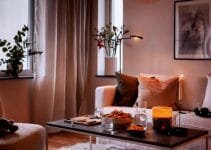Discover the essence of Scandinavian design for small living rooms. Emphasizing minimalism, functionality, and natural elements, this guide provides insights on optimizing space with clean lines, neutral color palettes, and multipurpose furniture. From maximizing natural light to incorporating textures and nature, transform your compact living area into a stylish and serene sanctuary. Explore tips on selecting the right furniture, storage solutions, and design inspirations to create a modern, cozy retreat. Perfect for enhancing both aesthetics and practicality in limited spaces.
Introduction to Scandinavian Style
Scandinavian design, originating from the Nordic countries of Sweden, Denmark, Finland, Norway, and Iceland, has become a prominent interior design trend globally. Emerging in the early 20th century, this design philosophy celebrates minimalism, functionality, and simplicity. These core attributes make Scandinavian style particularly well-suited for small living rooms, where space optimization is paramount.

Key characteristics of Scandinavian design include clean lines, muted color palettes, and a focus on natural materials such as wood, leather, and wool. The emphasis is on decluttering and creating an environment that is both aesthetically pleasing and highly functional. This pragmatic approach not only enhances the visual appeal of compact spaces but also maximizes their utility.
Please read our article watch the newly uploaded video from our YouTube channel:
“Grig Stamate – Interior Design Solutions”
https://www.youtube.com/@GrigStamate
Small Living, SCANDINAVIAN STYLE [New Modern Living Rooms with Limited Space] (video)
Here, you can see other related videos from our channel:
Small Living, BIG STYLE [New Modern Living Rooms with Limited Space], #7 (video)
Small Living, BIG STYLE [New Modern Living Rooms with Limited Space], #8 (video)
A typical Scandinavian living room features an uncluttered layout, ergonomic furniture, and an abundance of natural light. Neutral tones like white, beige, and soft grays dominate, allowing for a sense of openness. Pops of color are often introduced through textiles and accent pieces, adding warmth and personality without overwhelming the space.
Functionality is another cornerstone of Scandinavian design, making it an excellent choice for small living rooms. Multi-purpose furniture, like sofas with hidden storage or wall-mounted shelving units, are common elements. These practical solutions help maintain a tidy, organized environment and make the most of limited square footage.
Moreover, the seamless blend of indoor and outdoor elements, such as incorporating plants and using natural light effectively, creates a refreshing and serene atmosphere. The inherent versatility of the Scandinavian style allows for customization to cater to individual tastes, making it a universally appealing choice for various homeowners.
In essence, the Scandinavian design ethos is about creating a space that exudes tranquility and functionality, perfectly fitting the requirements of modern living. Its minimalist yet inviting nature provides a simple yet elegant solution for transforming compact living rooms into stylish and practical sanctuaries.
Key Elements of Scandinavian Interior Design
Scandinavian interior design is renowned for its minimalist yet cozy aesthetic, making it an excellent choice for small living rooms. At the core of this style are clean lines and a functional approach to decor. Furniture usually features simple, sleek designs that contribute to an uncluttered appearance, creating an airy and open atmosphere even in confined spaces.
A neutral color palette is another defining characteristic of Scandinavian design. Whites, grays, and soft pastels dominate the scene, providing a clean backdrop that enhances natural light. This choice of colors not only enlarges the visual perception of a space but also offers a calming and serene environment. Incorporating monochromatic tones with small accents of muted colors can further add depth without overwhelming the room.
Natural materials, particularly wood, play a significant role in Scandinavian interiors. Think of light-colored woods like pine, ash, or beech to maintain that bright and inviting look. The use of natural textures is effortlessly integrated into both furniture and structural elements such as flooring and accent walls. This inclusion of organic components adds warmth and grounding to any compact living area.
Lighting is crucial in Scandinavian design. Given the Nordic region’s long, dark winters, maximizing natural light is paramount. Large windows, often left uncovered or adorned with sheer curtains, flood the room with daylight. Additionally, strategically placed mirrors can reflect light throughout the room, further enhancing the luminosity and sense of space. Artificial lighting that mimics natural light, such as warm white LED fixtures, contributes to the room’s overall brightness and comfort.
Overall, the key elements of Scandinavian interior design work in harmony to create an environment that feels expansive, welcoming, and effortlessly stylish. By integrating these principles, it is possible to transform even the smallest living rooms into functional and aesthetically pleasing retreats.
The Importance of Light in Scandinavian Living Rooms
Light, both natural and artificial, plays a pivotal role in Scandinavian design, especially in compact living spaces. This design philosophy, which originates from the Nordic countries where daylight hours can be limited, emphasizes creating bright, airy environments that offset the darker months. In Scandinavian living rooms, maximizing light is not merely a stylistic choice but a functional necessity to improve the overall ambiance and perceived space.
Large windows are quintessential elements in Scandinavian interiors. They are often left bare or adorned with sheer curtains that allow maximum light penetration. The absence of heavy drapes ensures that the room remains well-lit throughout the day, creating an illusion of expanded space. The aim is to create a seamless transition between the indoor and the outdoor environment, making the room feel more connected to nature.
Mirrors are another strategic element widely used in Scandinavian design to maximize light. Placing mirrors opposite windows or light sources reflects natural light back into the room, amplifying its effect. This reflection not only brightens dark corners but also adds depth, making the living space feel considerably larger than it actually is. Mirrors with minimalistic frames or unique geometrical shapes often add an extra layer of visual interest to the decor.
In addition to natural light, artificial lighting is meticulously planned in Scandinavian living rooms. Multiple light sources are often distributed throughout the room to eliminate shadows and create a warm, inviting atmosphere. Pendant lights, wall sconces, and floor lamps with sleek designs enhance the Scandinavian aesthetic while providing functional illumination. The focus is on layering different types of lighting to cover varying needs from general illumination to task-specific lighting without overwhelming the space.
Strategic lighting placement cannot be overstated in the context of small living rooms dressed in Scandinavian style. It ensures that the room feels cohesive, open, and undeniably brighter, embodying the essence of Scandinavian design principles that prioritize light, simplicity, and functionality.
Furniture Selection for Small Scandinavian Living Rooms
When designing a small living room with a Scandinavian touch, choosing the right furniture is crucial for achieving a balanced blend of functionality and simplicity. The hallmark of Scandinavian style lies in its minimalist approach, emphasizing clean lines, natural materials, and practical solutions. One essential element to consider is multipurpose furniture, which not only saves space but also enhances the room’s versatility.
Stackable stools serve as an excellent example of this principle. They can be effortlessly stored when not in use, freeing up valuable floor space. Additionally, these stools often come in sleek and stylish designs that complement the minimalist aesthetic. Convertible sofas are another staple in Scandinavian interiors. These pieces can transform from a comfortable seating area during the day to a cozy bed at night, making them perfect for small living rooms. Opt for models with hidden storage compartments to further maximize space.
Wall-mounted shelving is indispensable when working with limited square footage. These shelves not only provide ample storage without occupying floor space but also contribute to the room’s open and airy feel. They can be used to display books, plants, and decorative items, adding a personal touch to the living room while keeping the area organized.
Maintaining harmony between aesthetics and functionality is paramount in Scandinavian design. Furniture should be crafted from natural materials such as wood, which brings warmth and texture to the room. Neutral colors like white, gray, and beige are preferred, as they contribute to a serene and uncluttered atmosphere. To introduce subtle color accents, consider accessories like cushions and throws.
In summary, the key to furnishing a small Scandinavian living room lies in selecting multipurpose and space-saving pieces that uphold the style’s signature look. By carefully choosing items like stackable stools, convertible sofas, and wall-mounted shelving, one can create a functional yet beautiful living space that embodies the essence of Scandinavian design.
Using Textures and Patterns
Incorporating various textures and patterns can significantly enhance the aesthetic appeal and comfort of a small living room, even while maintaining the minimalist principles characteristic of Scandinavian interior design. The strategic use of textures and patterns not only adds visual interest but also introduces warmth and personality to the space. One effective method to achieve this is by integrating soft furnishings, such as rugs, throw pillows, and cozy blankets. These elements not only serve functional purposes but also act as aesthetic components that enrich the overall ambiance.
Opt for rugs that feature simple, clean designs. Natural fibers such as wool, jute, or cotton can ground the room and add an organic touch. A neutral-toned rug with a subtle geometric pattern can create a sophisticated, understated look without overwhelming the space. When choosing throw pillows, mix and match different fabrics like linen, velvet, and knit materials to introduce layers of texture. Select pillows in complementary colors and modest patterns, such as thin stripes or small-scale checks, to maintain a harmonious and uncluttered vibe.
Cozy blankets or throws draped over a sofa or armchair not only provide comfort but also contribute to the room’s textural depth. Consider materials like chunky knits, soft fleece, or woven fabrics. These elements can be chosen in muted tones to complement the existing color scheme or in pastel shades to add a cautious pop of color. The key is to balance different textures to create a cohesive and inviting environment that does not stray from the minimalist ethos.
By thoughtfully introducing these textured and patterned elements, your small living room can achieve the perfect combination of warmth, character, and Scandinavian simplicity, ensuring a space that is both stylish and comfortable.
Maximizing Storage Solutions
Efficiency in storage is fundamental when designing a small living room with Scandinavian style. Integrating built-in storage units is a transformative approach that maximizes space while maintaining the minimalist aesthetic central to this design philosophy. Built-ins seamlessly blend with existing structures, offering ample room to stash away personal items and reducing visual clutter. Custom shelving units tailored to your living room’s dimensions can provide considerable storage without encroaching upon the limited square footage.
Similarly, under-sofa storage emerges as a practical solution in small living rooms. Utilizing this often-overlooked space can significantly enhance your storage capacity. Opt for sofas with built-in storage compartments or invest in sleek storage boxes that can slide under. This approach ensures that essentials, such as extra blankets or off-season decorations, are within easy reach but remain out of sight, adhering to the Scandinavian principle of maintaining a visually clean environment.
Vertical shelving is another critical strategy for maximizing space in compact living areas. Wall-mounted shelves or tall bookcases draw the eye upward, creating an illusion of a larger space while providing valuable storage. These vertical solutions can house books, decorative items, or even everyday essentials in stylish, minimalist storage baskets. The key is to spread out storage vertically rather than relying solely on limited horizontal space, thus preserving the room’s open feel.
Keeping the space clutter-free is vital to achieving the serene and airy ambiance that Scandinavian design is renowned for. Regular decluttering and mindful organization are necessary to prevent accumulation and maintain the room’s clean lines. Invest in multi-functional furniture pieces, such as ottomans with hidden storage or coffee tables with shelves, to further minimize clutter. By adopting these smart storage solutions, you can effectively optimize your small living room without compromising on style or functionality.
Bringing Nature Indoors
Incorporating elements of nature into your living space is a fundamental tenet of Scandinavian design. This approach not only aligns with the minimalist ethos of the style but also brings a sense of calm and tranquility to small living rooms. Indoor plants are an excellent way to introduce natural beauty and life into your home. Their presence can purify the air, add a refreshing pop of green, and create a connection to the outdoors.
Wood is another crucial material in Scandinavian interiors, echoing the region’s deep affinity for nature. Light-toned woods like pine or birch are particularly favored for their ability to brighten up the room and enhance the sense of space. Consider wooden floors, furniture, or even smaller decor items such as picture frames or shelves to introduce this organic element. The natural texture and grain of wood can add warmth and depth, making a compact living area feel more inviting.
Stone is yet another natural material that can elevate the Scandinavian aesthetic. Whether it’s a stone coffee table or a simple decorative piece, the rugged, raw quality of stone can inject a touch of rugged sophistication into your space. Pairing stone with wooden elements creates a balanced contrast that is visually appealing and rooted in nature.
Natural materials and indoor plants aren’t just about aesthetics; they play a functional role in creating a more serene and breathable environment. By adopting elements from the natural world, you can transform a small living room into a sanctuary that fosters a sense of well-being and relaxation. To maximize the effect, ensure that the elements you choose are proportionate to your space to maintain the openness and uncluttered vibe that Scandinavian design champions.
Design Inspirations and Final Thoughts
Adopting Scandinavian design principles in small living rooms offers an array of benefits that go beyond aesthetics. Its minimalist, functional, and light-filled style transforms compact spaces into inviting and practical environments. By integrating natural elements, utilizing a neutral color palette, and emphasizing purposeful furniture, you can make the most of limited square footage.
Throughout this blog, we’ve shared various tips to enhance your living area with Scandinavian design. Implementing these ideas can result in not only a visually pleasing space but also one that feels roomy and comfortable. From selecting multi-functional furniture to incorporating cozy textiles, every element plays a critical role in the overall ambiance.
For more detailed guidance and inspiration, don’t miss our video series, ‘New Modern Living Rooms with Limited Space.’ This series showcases over 50 design ideas specifically tailored to small living rooms. Watching these videos will provide you with deeper insights and practical examples of how to implement Scandinavian style effectively.
As you embark on your design journey, remember that personalization is key. Experiment with the suggestions we’ve shared, and adapt them to fit your unique space and taste. Whether you’re updating existing decor or starting from scratch, the goal is to create a living area that reflects your personality while maximizing functionality.
In conclusion, embracing Scandinavian design in a small living room can significantly enhance both the look and feel of your home. With streamlined furniture, thoughtful use of light, and a focus on simplicity, you can transform a compact space into a cozy, modern retreat. Happy decorating!
Other related posts from our website:
Let’s see here, three of them:
https://howtobuildahouseblog.com/cute-small-apartments-tiny-interiors-under-400-sq-ft-37-sq-m-4/
Thank you so much for your attention.
We also sincerely hope you like our ideas from this post, and you have also enjoyed our uploaded YouTube video.
See you next time at another article. Thank you so much for your time. Bye now!


![Small Dreamy Family Homes [NORDIC STYLE] #10 Small Dreamy Family Homes [NORDIC STYLE] #10](https://howtobuildahouseblog.com/wp-content/uploads/2025/02/SnapShot0-2-211x150.jpg)
No Responses